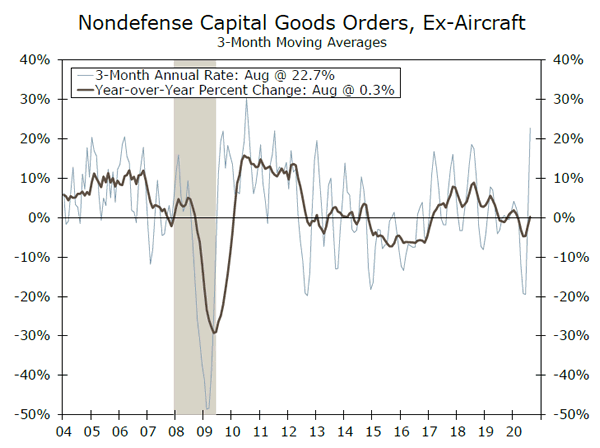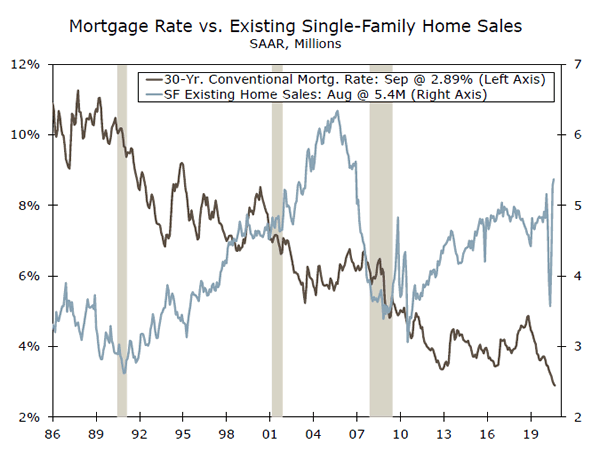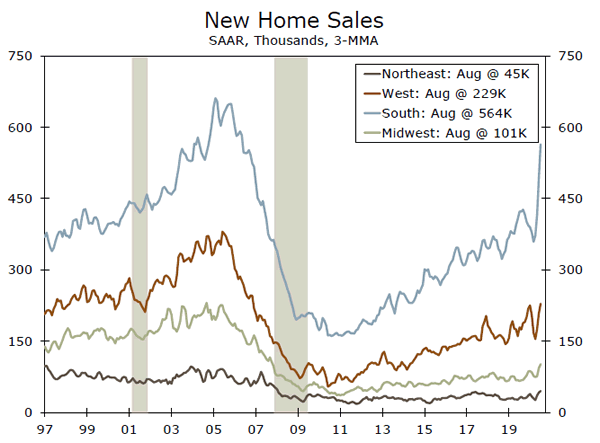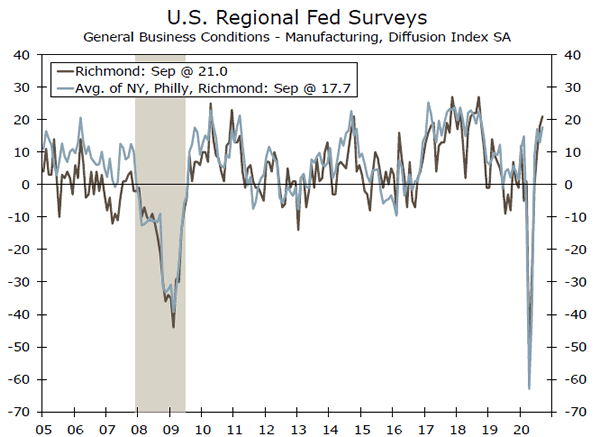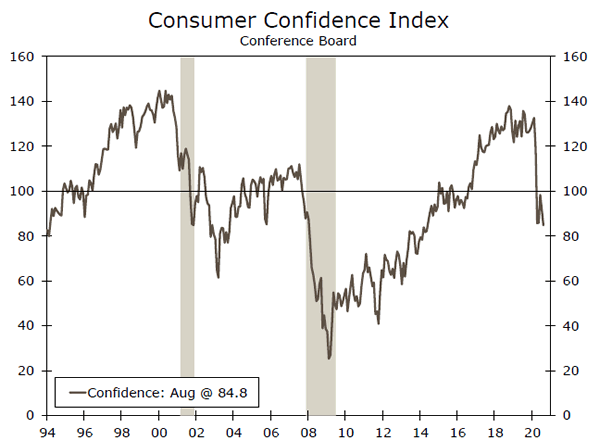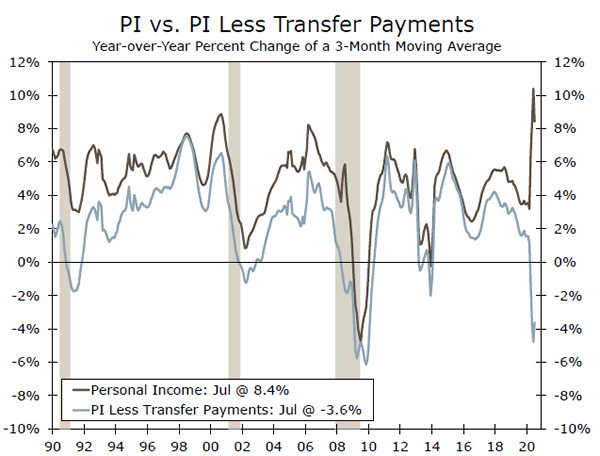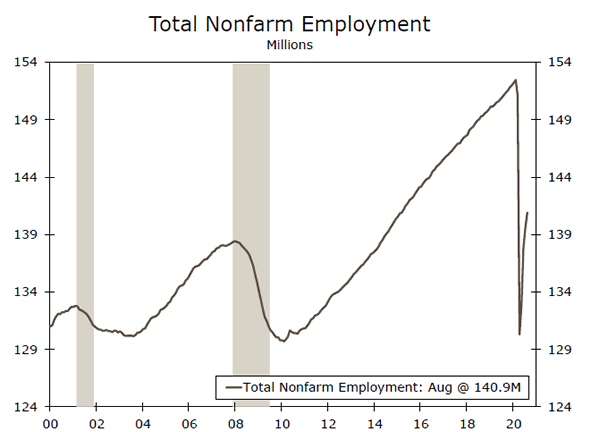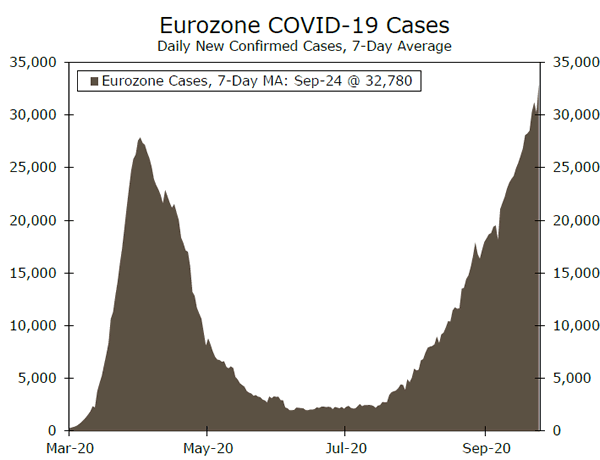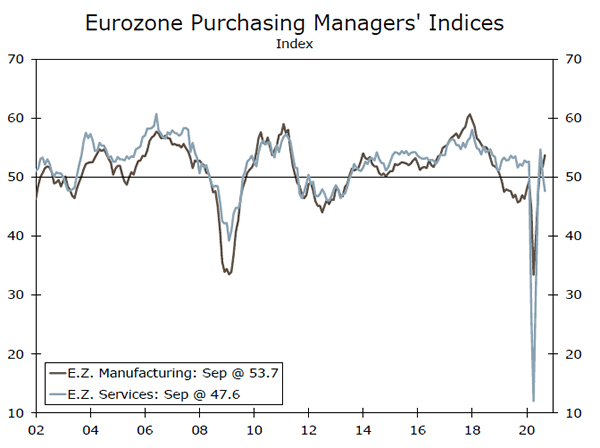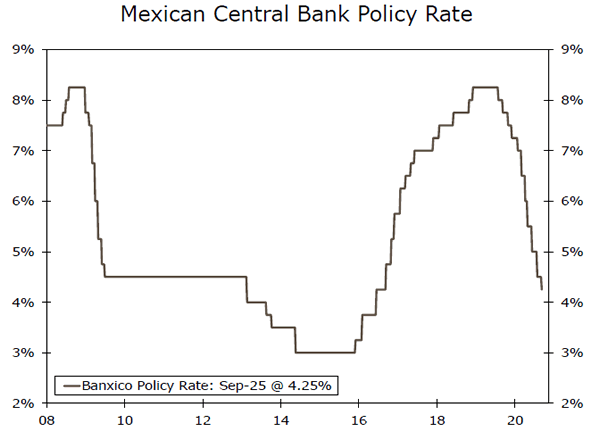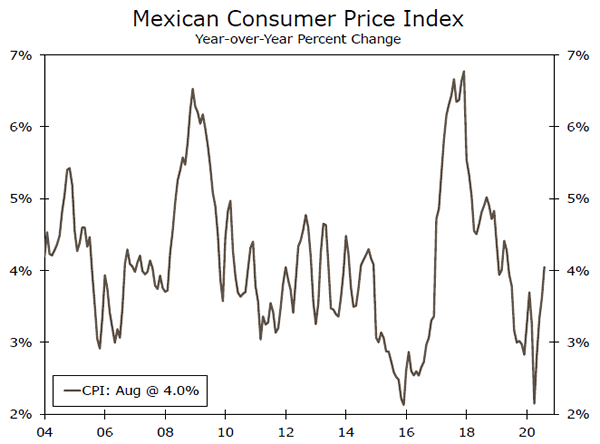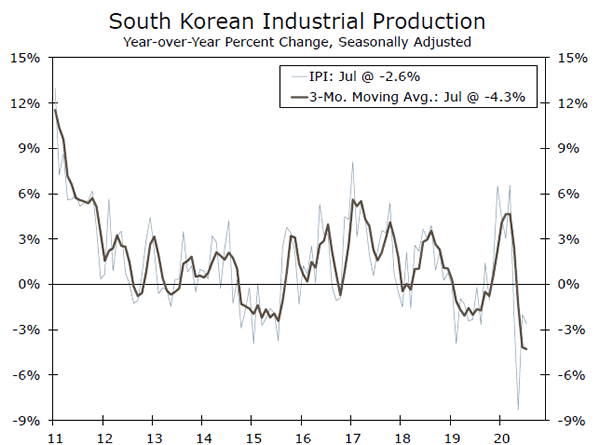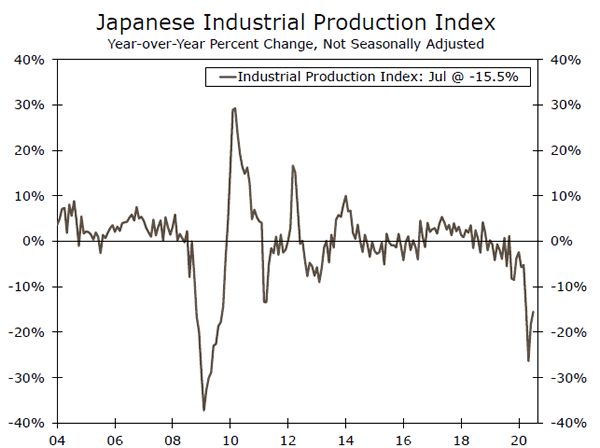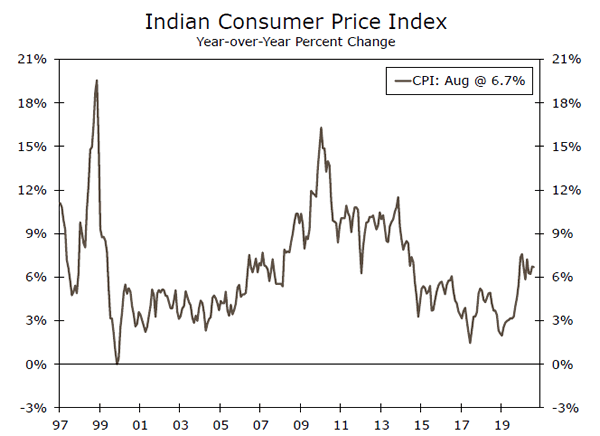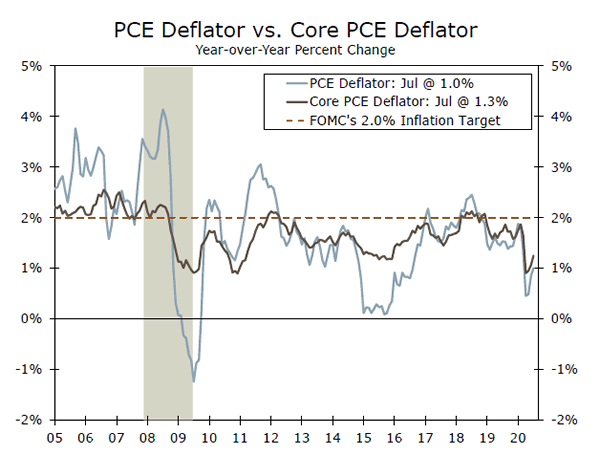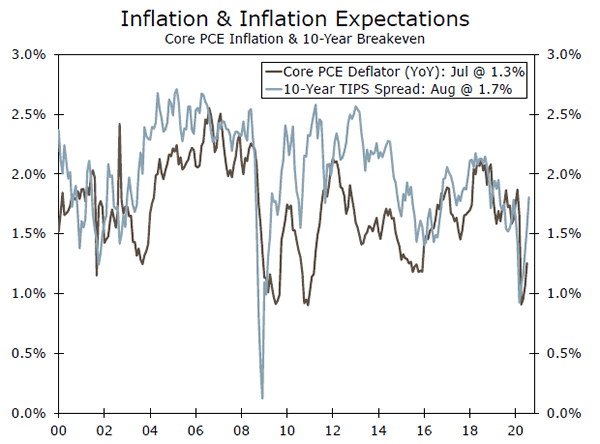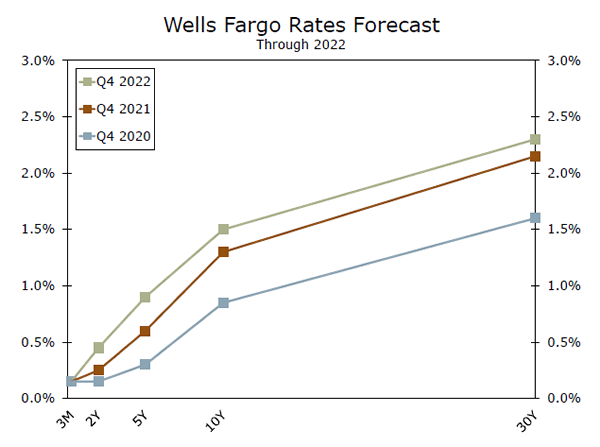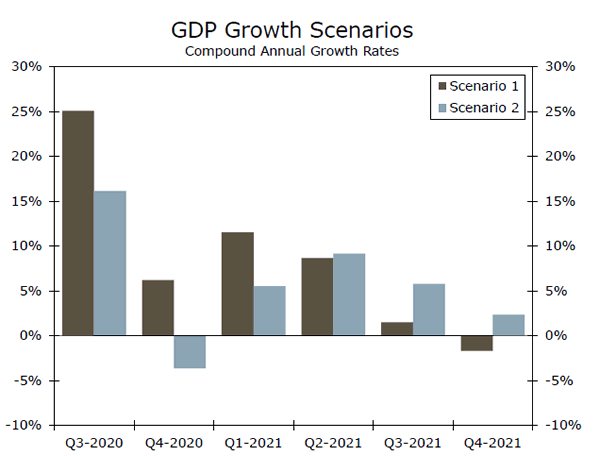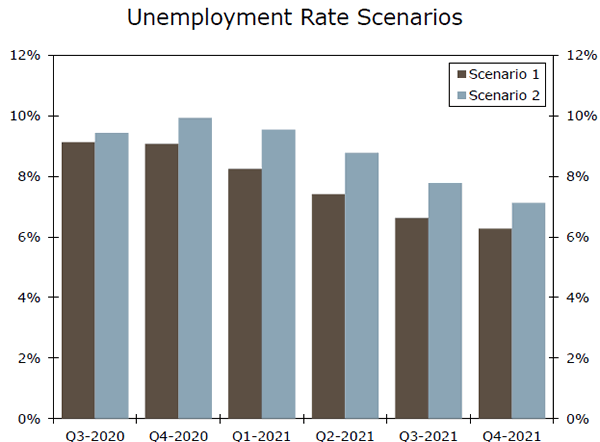U.S. Review
More Strong Housing Numbers
- Existing home sales rose 2.4% to a 6.0-million unit annual pace. The surge in sales further depleted inventories and pushed prices sharply higher.
- The IHS Markit Purchasing Managers’ survey noted that manufacturing conditions improved in September.
- New home sales soared 4.8% to a 1.011-million unit pace, marking the strongest sales pace since September 2006.
- Durable goods orders were stronger than the 0.4% headline gain suggests. Core nondefense capital goods orders rose 1.8%, and are up at a 22.7% pace over the past three months.
Fortifying the Nest and Adding an Addition or Two
The housing data continue to show a great deal of strength. Sales of both new and existing homes topped lofty expectations this past week and mortgage applications bounced back from their Labor Day week drop. Housing demand appears to be fueled by the need for more affordable living space. More renters are choosing to purchase homes once their lease expires and others are moving back in with their parents or other relatives, driving the need for more living space. Demand is being further stoked by more people working from home and attending school and college remotely. The move away from large cities to mid-sized metropolitan areas is also driving demand, with exurban counties showing the strongest growth in single-family housing starts.
As strong as home sales have been, they would have likely been even stronger if there were more homes available for sale. Existing home sales rose 2.4% to a 6.0-million unit pace in August, which cut inventories 0.7% to 1.49-million units at the end of the month. The number of homes for sale is a whopping 18.6% below its year-ago level, while sales are up 10.5%. With demand surging and supply contracting, prices have soared. The median price of an existing home has risen 11.4% over the past year, and all four regions of the country posted double-digit year-to-year price gains.
The surge in home prices is fueling an affordability migration that will likely have lasting consequences. Data on migration trends lag considerably, but anecdotal reports from moving companies, as well as recent trends in new home sales, suggest there is a major movement from high-cost, large metro areas along the West Coast and Northeast to the South. The shift is most apparent in mid-sized metro areas such as Austin, Nashville, Charlotte, Raleigh and Greenville. Large metro areas in the South are also benefitting, most notably Tampa, Atlanta and Dallas. The outlying counties of these large metros—or exurbs—share many of the characteristics of mid-sized metros and are clearly doing the best. We are hesitant to say that people are abandoning cities, yet, submarkets closer to major metro areas in the South are still seeing strong existing home sales and plenty of infill development. Prices are soaring, however, which is fueling the affordability migration.
Housing is typically a powerful driver for the rest of the economy, and we are already seeing clear evidence of this at home improvements stores, furniture retailers, and manufacturers of building materials, furniture and appliances. The economic multiplier is even greater today, as so many existing homeowners are scrambling to upgrade home workspaces and offices and also improve kitchens, dining spaces, and outdoor spaces—where they are spending so much more time than in the past.
We see some evidence of this follow through in the Richmond Fed’s manufacturing survey, which has rebounded faster than many other regions. Virginia and the Carolinas are home to much of the nation’s furniture and home furnishings industries, which has been a big contributor to the recent improvement in manufacturing. The improvement in durable goods orders also suggest the recent pick up in manufacturing likely has a ways to go.
U.S. Outlook
Consumer Confidence • Tuesday
Readings from the Morning Consult’s daily survey of consumer sentiment, as well as the preliminary report on consumer sentiment from the University of Michigan, moved in the right direction in September. While these indicators are not perfectly correlated with the Conference Board’s consumer confidence index, they suggest sentiment may be turning around after a two-month retreat.
As the number of new COVID-19 cases rose throughout the summer and Congress balked at another expansive stimulus package, consumers’ confidence in the fledgling recovery slipped. While the odds of another stimulus package have fallen since the summer, the COVID-19 picture has improved. Continued improvement on the virus front is far from a sure thing, but the progress since August should help buoy sentiment for the time being. We look for September Consumer Confidence to rise to 89.6.
Previous: 84.8 Wells Fargo: 89.6
Consensus: 90.0
Personal Income & Spending • Wednesday
Personal income surprised to the upside in July, eking out a 0.4% gain when the consensus called for a decline. July’s increase was much more broad-based then the 12.2% spike in April, with wages & salaries, rental and proprietors income all rising. An outright gain will be much harder to come by for August, however. The $600 federal top-up on weekly unemployment insurance expired at the end of July. The program had played a key role in boosting incomes throughout the spring and summer. While non-transfer income has been improving over the last few months, it likely will not be enough to offset the expiring benefits.
Beyond August’s print, the extent to which wages & salaries can replace receding government stimulus will have important implications for consumer spending. Thus far, stimulus efforts have helped boost demand for goods and bolster household finances, as evidenced by the soaring saving rate.
Previous: 0.4%; 1.9% Wells Fargo: -2.5%; 0.8%
Consensus: -2.1%; 0.7% (Income; Spending)
Nonfarm Payrolls • Friday
Payroll growth has slowed over the past few months and we expect it slowed further in September. Census hiring, which boosted the August headline by roughly 240,000 jobs, is set to become a drag in September, with the number of temporary census workers falling by about 40,000 between the August and September survey weeks. Measures of small business employment from Homebase are flat or down since mid-August, depending on adjustments for the Labor Day holiday. Meanwhile, the number of weekly initial unemployment claims has stopped falling. Though the number of continuing claims has fallen 1.9M since August’s survey week, the lack of improvement in initial claims suggest that labor demand remains poor. Thus, the jobs report next Friday is unlikely to show another 1M+ gain. While our expected gain of 820K would be remarkable pre-COVID, it is now a sign of slowing momentum when the economy remains down 11.5M jobs since February.
Previous: 1,371K Wells Fargo: 820K
Consensus: 900K
Global Review
Eurozone Recovery Threatened by Surging COVID Cases
- Surging new COVID-19 cases across Europe have threatened the continent’s economic recovery. Daily new cases are now above the peak seen in March/April, although this does not account for differences in testing.
- Against this backdrop, Eurozone September PMI indices were closely scrutinized by market participants this week. The services PMI showed further weakness, falling into contraction territory at 47.6.
- Elsewhere, the Bank of Mexico cut its overnight interbank interest rate 25 bps to 4.25%. Most forecasters in the Bloomberg survey expected the cut.
Eurozone Recovery Threatened by Surging COVID Cases
The COVID-19 outbreak and associated lockdown measures took a severe toll on the Eurozone economy as GDP slumped 15% in the first half of the year. However, since spring we have become increasingly hopeful on Eurozone economic prospects given the actions taken by (monetary and fiscal) policymakers and as activity data and confidence surveys have shown a relatively quick initial rebound from the deep downturn.
However, that more hopeful outlook has faced some questions in recent weeks. Retail sales unexpectedly declined in July, while the August services PMI dipped sharply to 50.5. Meanwhile, after the spread of COVID-19 slowed across the Eurozone during the summer months, the acceleration in new cases has jumped again as we enter the fall. New daily cases are now above the peak seen in March/April (see chart on front page). The rise in cases has raised concerns that the partial re-imposition of lockdown restrictions could restrain the rebound and lead to a disappointing pace of recovery.
Against this backdrop, Eurozone September PMI indices were closely scrutinized by market participants this week. The services PMI showed further weakness, falling into contraction territory at 47.6 (top chart). The new business component fell to 47.7 and the employment sub-index eased to 47.6, both consistent with declining activity. The Eurozone manufacturing PMI fared better, rising to 53.7, with an increase in the new orders component to 57.1. But the employment sub-index, like the service sector, was also in contraction territory.
We believe that underlying policy fundamentals remain growth supportive, with Italy, France and Germany among the countries announcing further fiscal stimulus in recent months. We also believe European governments will be hesitant to re-impose the widespread, large-scale lockdown measures seen earlier this year. That said, with less confident businesses and households, as well as the potential imposition of further partial restrictions, we believe there are downside risks to our outlook for the Eurozone. Specifically, the risks to our GDP growth outlook of 8% quarter-over-quarter for Q3-2020 and our longer-term forecast of a 5.3% increase for calendar year 2021 are both tilted to the downside.
Elsewhere, the Bank of Mexico cut its overnight interbank interest rate 25 bps to 4.25% (middle chart). Most forecasters in the Bloomberg survey expected the cut. The Mexican economy needs as much policy support as it can get: retail sales were down 12.5% year-over-year in July, and an overall economy activity index was still down 9.8% over the same period. Fiscal support for the Mexican economy has been lighter than it has in many other major economies. And although the Bank of Mexico has cut its main policy rate 400 bps since May 2019, more recently policymakers have had to be cognizant of inflationary pressures. CPI inflation in Mexico was 4.0% in August, above the central bank’s 3.0% target (bottom chart). On balance, it appears the Bank of Mexico viewed the benefits from further easing to outweigh the cons, but further increases in realized inflation and inflation expectations could put a halt to additional easing.
Global Outlook
S. Korea Industrial Production • Monday
The South Korean economy continues to perform reasonably well due to its relatively successful efforts to control the spread of COVID-19. Year-to-date, real retail sales and industrial production are about flat compared to 2019. While no economic growth is certainly not a great outcome in normal times, given the downturns experienced in other major developed economies, a roughly flat economy in 2020 for South Korea would be quite the accomplishment.
Unfortunately, further upside for the South Korean economy may be limited unless foreign demand picks up. Exports accounted for about 40% of South Korean GDP at the end of 2019, and in August they were still down about 10% year-over-year. Initial data for September were a bit better and suggest that exports may have risen on a year-over-year basis for the first time since March. Next week’s industrial output data for August will offer some additional signals about whether South Korean factories are ramping up heading into the fall.
Previous: 1.6%
Consensus: 0.3% (Month-over-Month)
Japan Industrial Production • Tuesday
Industrial production in Japan has not been quite as resilient as in South Korea. Industrial output was down 15.5% year-over-year in July and 12.6% year-to-date. Retail sales, which are also reported for the August period next week, have been stronger but were still down 2.9% year-over-year in July.
New COVID-19 cases in Japan peaked in mid-August, although at roughly 1,600 the peak was much lower than the peaks seen in the U.S., Europe and elsewhere. Since then, new cases have been steadily declining, and the seven-day moving average of new deaths has been in the single digits of late. If industrial output and retail sales kept growing during that rocky August period, it should bode well for a continued recovery into September given the better public health situation this month. Household income growth in Japan has been significantly boosted by government transfer payments, and a low level of COVID cases is key to unleashing this pent up income.
Previous: 8.7%
Consensus: 1.5% (Month-over-Month)
Reserve Bank of India Meeting • Thursday
Data released for the Indian economy showed that real GDP got crushed in the second quarter, even compared to many other hard-hit countries. Real GDP contracted 23.9% year-over-year, led by a 47.1% decline in gross fixed capital formation and a 26.7% contraction in private consumption. To put that 23.9% decline into perspective, consider that in Italy and the United Kingdom, two of the hardest-hit countries in the world, Q2 real GDP growth was -17.7% and -21.7%, respectively.
Despite this, the Reserve Bank of India (RBI) refrained from additional rate cuts in August due to above-target inflation. Food accounts for nearly half of the Indian CPI, and the increase in global food prices creates a difficult economic reality for monetary policymakers in India. Inflation remained relatively high at 6.7% in August. As of this writing, the Bloomberg consensus expects the RBI to once again keep its main policy rates on hold next week.
Previous: 4.0%
Consensus: 4.0% (Repurchase Rate)
Point of View
Interest Rate Watch
And if Inflation Doesn’t Hit 2%…?
The change that the FOMC recently made to its policy strategy means the Committee is willing to tolerate a higher rate of inflation in the next few years. The FOMC would like to raise inflation now so that it has farther to fall before reaching negative territory if the economy were to tumble back into recession (top chart).
It will be difficult for the Fed to engineer higher inflation if it fails to raise inflation expectations. Market measures of long-term inflation expectations have been below 2% for nearly two years. Moreover, the 10-year breakeven inflation rate is actually a bit lower today than on the day Chair Powell outlined the FOMC’s new policy strategy.
If inflation expectations do not move meaningfully higher in coming months, the FOMC may feel compelled to add more monetary accommodation. Fed officials have generally downplayed the use of negative interest rates, while circumstances would have to change “markedly” for the Fed to try yield curve control according to the July meeting minutes.
In our view, an increased pace of purchases of Treasury securities and MBS (i.e., quantitative easing or “QE”) would therefore be the most likely policy tool employed, at least in the foreseeable future. The FOMC could potentially sanction increased QE purchases as early as its December 15-16 meeting, assuming financial conditions do not tighten significantly before that.
The middle chart shows that the 10-year breakeven inflation rate rose about one percentage point during the Fed’s second round of QE in late 2010/early 2011. So an increase in the Fed’s pace of QE purchases could potentially have the desired effect of raising inflation expectations.
In our view, yields on longer-dated Treasury securities likely would move lower, at least initially, if the Fed were to ramp up QE. However, longer-term rates, could eventually begin to drift higher if investors became convinced that the Federal Reserve would ultimately be successful in achieving a higher rate of inflation. For a more detailed discussion, see, What Will the Fed Do if Inflation Doesn’t Hit 2%?
Credit Market Insights
Shop ’til You Drop: Fed Edition
In response to liquidity disruptions at the onset of the pandemic, the Federal Reserve launched a new agency mortgage-backed security (MBS) purchase program in March. The FOMC specifically committed to increase its holdings of agency MBS by at least $200B in the coming months. Since the announcement, holdings have increased $624B to a total of nearly $2 trillion as of mid-September. The bank now owns 30% of all outstanding agency mortgage bonds.
The Fed first introduced this tool to help ease tightening financial conditions in the wake of the Great Recession. During that time, the Fed’s holdings of agency MBS peaked just below $1.8 trillion. Overall, the purchase program helped foster more accommodative borrowing terms by putting downward pressure on longer-term interest rates. The FOMC has zeroed in on the MBS market as it is central to the flow of credit to households and businesses. Further, agency MBS (namely those issued by Fannie Mae, Freddie Mac or Ginnie Mae) account for the majority of the market in the United States, so the program has a broad-based impact.
Recently, the Fed stated in its September meeting that it will continue to increase its holdings at least at its current pace. At this rate, it would add an additional $900B in holdings by the end of the year. Thus far, the Fed’s agency MBS purchases appear to be supporting low mortgage financing costs, which have helped fuel a rapid recovery in home sales, builder confidence and new residential construction.
Topic of the Week
Will the Economy Crater if Unemployment Benefits Expire?
The Pandemic Unemployment Compensation (PUC) program, which paid unemployed individuals $600 per week on top of normal benefits, expired at the end of July. Lawmakers in Washington, D.C. are currently debating whether to re-instate this program, at least in part. Both the Pandemic Unemployment Assistance (PUA) program, which applies to workers who usually do not qualify for benefits, and the Pandemic Emergency Unemployment Compensation (PEUC) program, which provides benefits to individuals who have exhausted their regular benefits, are set to expire on December 31. How important are these programs to a continued recovery?
We built on our prior analysis and ran two income scenarios in an effort to answer this question. In scenario one, we simulate a continuation of unemployment benefits by holding monthly nominal disposable income constant at its July level of $1.5T (before PUC expired) through 2021. In scenario two, we simulate the expiration of benefits by subtracting the $75B of monthly PUC payments from August to December income levels and let the $16.8B of monthly PUA and PEUC expire starting in January where we then held income levels constant through the end of 2021. Under scenario two, GDP declines at an annualized rate of 3.6% in Q4-2020 (top chart). The drop in disposable income from the expiration of PUC pulls down real personal consumption expenditures (PCE) 2.5% during the quarter. In contrast, GDP growth remains positive through most of next year under scenario one. The contraction in real GDP under scenario two also causes the unemployment rate to edge up in Q4-2020, and to remain in excess of 7% at the end of 2021.
But, there is reason to believe scenario 2 might overstate the negative economic consequences. For starters, employment growth appears to have remained positive through September, which should help to support income and PCE. Further, the elevated savings rate may give jobless individuals the financial wherewithal to continue spending, at least for the time being. Nonetheless, the model results indicate that there are downside risk to the outlook if the programs expire as scheduled.




